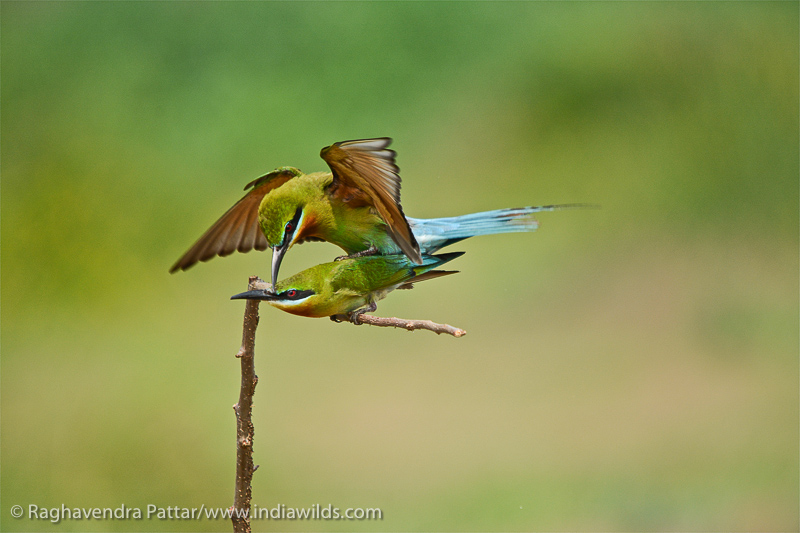Wake-up Call to Save a Paradise
Amidst the enveloping dusk, the teeming flocks of spotted ducks and Egrets were a delight to watch in the magical village of Naguvanahalli. Situated in Shrirangapattana Taluk in Mandya district, this small village is a part of Mysore division and is located at 32 kms toward west from District headquarters of Mandya and 3 kms from Shrirangapattna which is 137 kms from the Karnataka’s Capital Bangalore.
I set my journey to Naguvanahalli, a 3-hrs drive from the capital city, which is slowly making a mark on the birding map of India. Inhabited with nearly 46 species of birds, I found the bee eaters had excavated their nesting tunnels on the earthen bund counting close to 60 to 70 active nests. I could see the bee eater, an exquisite little bird with bright emerald green plumage actively soaring. The little green bee-eater can be identified by a narrow black stripe on its throat, known as a ‘gorget’, as well as a black ‘mask’ that runs through its crimson eyes. Also distinctive are the two central, long, narrow, bright blue tail streamers.
Like other bee-eaters, this species are slightly larger than the common small green bee-eater. The sexes are not visually distinguishable. The entire plumage is bright green and tinged with blue especially on the chin and throat. The crown and upper back are tinged with golden Rufus. The flight feathers are rufous washed with Blue and tipped with blackish. The iris is crimson and the bill is black while the legs are dark grey. The feet are weak with the three toes joined at the base. The wings are green and the beak is black. The elongated tail feathers are absent in juveniles.
Sexes are alike. Adult males and females are similar in appearance but can usually be distinguished by the difference in body length and by the fact that a female’s tail-shafts are shorter, thicker and have broader tips than those of a male. These can also be identified from the way they collect their prey. Their typical hunting methods are noteworthy.
We formally began bird watching and photography by 8.00 am. Our first bee-eater was smugly perched on a twig, and glancing on all sides, as if admiring the landscape. It detected a dragonfly about 100 feet away, where no human eye could reach and took to air in a jiffy. In mid-air it clicked its pointed beak over the winged insect, fluttered for a moment, cart wheeled and sallied back to its perch. In no time, it battered the dragonfly on the perch and took it to the nest to feed its chicks. The bee-eaters at the nesting colony were maintaining contact with each other, with their pleasant unmistakable jingling tree-tree-tree and teerp-teerp-teerp calls, all day long.
And just across the river lay a barren stretch that had nearly hundreds of blue tailed bee-eaters swarming around in the air and were perching almost at ground level! Not to be very metaphorical.. but it was almost as though we came across an oasis in the midst of a desert! I was ecstatic!
The blue-tailed bee-eaters are rare, colorful birds and feed on dragon flies and bees and are found in grassland, thin scrub and forest often quite far from water.
To make sure this was no mirage, we proceeded towards this patch – crossed a small canal, got all muddy, before realizing we have another track that can lead us straight to this patch by road, and yes this place was for real! We settled down and were awestruck at the sight – The ‘blue-tailed green bee-eater’ supposedly to be strongly migratory and seen seasonally in much of peninsular India and finding these slender, richly colored birds in the midst of a dhobi ghat (quiet literally) was definitely like a paradise!
Many bird watchers have a special love for the bee-eaters—there’s just so much power and personality packed in that tiny bundle of feathers. These bee-eaters are migratory – they migrate to breed and are found only in parts of peninsular India. The place is known for breeding of many small birds like white breasted king fisher, pipit, Common Blue Kingfisher, bushchat etc.,
Paradise of a different kind – why do I say so?
Well… it is a paradise because, of the sheer number of these birds are found here and the joy true nature enthusiast’s experience up and close with them. On the flip side, these birds – choose sandy banks or open flat areas as their nesting grounds and unfortunately this particular site is a dhobi ghat often used by villagers, who make the banks as colorful as the bird itself by littering it with plastic and other harmful wastes. Also, these birds frequent this area by March to breed and abandon nests by end of April and since it’s the breeding time – the birds often face a lot of disturbance due to the dhobi’s who let their donkeys loose to graze which often scare and disturb these birds from their nesting ground.
Behaviour and ecology
Like other species, bee-eaters predominantly eat insects, especially bees, wasps and ants most of which except the later are expertly caught in the air by making sorties from an open perch. Before swallowing prey, a bee-eater removes stings and breaks the exoskeleton of the prey by repeatedly thrashing it on the perch.
These birds are somewhat sluggish in the mornings and may be found huddled next to each other on wires sometimes with their bills tucked in their backs well after sunrise. They sand-bathe more frequently than other bee-eater species and will sometimes bathe in water by dipping into water in flight. They are usually seen in small groups and often roost communally in large numbers (200-300). The birds move excitedly at the roost site and call loudly, often explosively dispersing before settling back to the roost tree. This behavior is generally observed between the hours of 7:00 and 8:00am, and after 4:00pm.
This species is migratory in nature and is seen in different parts of peninsular India in different seasons. It is seen in Naguvanahalli during its breeding season.
The breeding season is from March to June. Unlike many bee-eaters, these are often solitary nesters, making a tunnel in a sandy bank. Bee-eaters are seasonally monogamous, and some species are monogamous over multiple seasons. Migratory species however are thought to form new pair bonds each breeding season. The courtship displays of the bee-eaters are rather unspectacular, with the exception of the “butterfly display” (where the wings of both sexes are held out while calling). Most members of the family engage in courtship feeding, where the male presents prey items to the female, and such feeding can account for much if not all of the energy females require for egg creation.
Like almost all coraciiforms the bee-eaters are cavity nesters. In the case of the bee-eaters the nests are burrows dug into the ground, either into the sides of earth cliffs or directly into level ground. Both types of nesting site are vulnerable, those on level ground are vulnerable to trampling and small predators, whereas those in cliffs, which are often the banks of rivers, are vulnerable to flash floods, which can wipe out dozens or hundreds of nests.
Bee-eaters may nest as single pairs, loose colonies or dense colonies. Smaller species tend to nest solitarily, while medium sized species do so in the smaller colonies and larger and migratory species nest in large colonies that can number in the thousands. In some instances colonies may contain more than one species of bee-eater.
Ethics: A note to photographers:
Please avoid going too close to the nest as this prevents the parents from taking food to the chicks inside the nest. Which means the chicks will starve because of you. Use a long lens and a hide. Even a makeshift hide made by hanging your green jackets and cloths will serve. Remember not to walk straight into the nesting area. Crawling in and out of the hide and keeping an in general lower profile helps in not scaring the birds. Remember that no image is more important than the welfare of the species.
Conservation Activity – Wake Up Call
Human activities can disrupt these green Bee-eater nests built in active mines or quarries. The local villagers visiting to the river bank to wash clothes have started drying their clothes on the ground or on the boulders, thus hindering nesting of the birds. Sand mining in the area too has led to the decrease in bird nesting. Following complaints about this from the local villagers, bird-watchers and wildlife photographers, Anil Kumble took note of the situation from the villagers and Gram Panchayat members.
Speaking to media persons, Kumble said that the place used to see birds numbering to thousands, which has now drastically reduced. If the same continues, the birds may stop migrating here.
Observing the clothes dried on the ground and on sand mining, Kumble had a discussion with forest officials about the measures to be taken to ban such activities. “Steps will be taken to fence around 7 acres of surrounding land where birds breed and a guard will be appointed to safeguard the place,” he said.
APCCF Shivananda Murthy, Ranganathittu Bird Sanctuary Forest Officer M. Shivappa, Village head Javaregowda and others were present during Kumble’s visit. Unfortunately, there has been no measures taken at this point of time.
- Wake-up call to Save a Paradise - 27 August,2014













Hello sir,
This is an amazing effort to enlighten people about wildlife and wildlife conservation.
Also,there are many people who want to be a part of this effort ( I may be the first one).
I am bsc zoology student and wish to contribute to wildlife and conservation.
Hope you would reply.
Thank you.
Hi Shweta,
Sorry for reverting late and thank you for interest and appreciation.
However if you are interested to participate in conservation of these birds you can write to me at coraghu@gmail.com.
Regards
Raghavendra Pattar
Hello Sir
It is an impressive work on the sustainability of bird’s habitat. I found a lot of lessons from this concise article. Thank you very much….
—– Sandipan Ghosh
Thanks and keep in touch.
You can write to me at coraghu@gmail.com.
Regards
Raghavendra Pattar
awesome!! Really a professional can do only these click!!
That is an amazing effort, sir. Great way to spread this great message. Hope we learn to save our environment for such beautiful creatures.